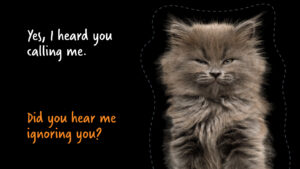Cats have real relationships with humans? Who knew? Well, every cat person on earth, for one. And every cat, ever, for two.
But in a world where dogs are the official Best Fur Friend, it seems a little science is required to make the point about pussycats and personal connection. Until recently, though, science wasn’t interested.

Along with popular opinion, the scientific community has long felt that felines fall outside the ‘secure attachment’ category. This is a phrase that describes the way dogs and children relate to people. Cat behaviour expert at Bristol University, John Bradshaw, categorically told National Geographic that “we've yet to discover anything about cat behaviour that suggests they have a separate box they put us in when they're socializing with us”. That was in 2014, though, and times have changed. Or, rather, the studies and the academics behind them have.
In October 2019, three researchers published a report stating that “research suggests we may be underestimating cats’ socio-cognitive abilities”. Krystin Vitale, Alexandra Behnke, and Monique Udell demonstrated that cats show recognisable attachment to their humans using clinical studies involving cuddles.
“I get that a lot”, lead author, Kristyn, an animal behaviour scientist at Oregon State University, told the New York Times. “Well, I knew that, I know that cats like to interact with me. But in science, you don’t know that until you test it.”
Changing the scientific status quo is a detailed and ongoing process. In 2017 the ladies found that cats prefer a person’s company to that of a snack or a toy. They also discovered that cats’ behaviour changes when they get more human attention. Still other studies from other scientists recognised that cats know how we are feeling. What the ladies have proven is that they care.
In one test, “they recruited owners of 79 kittens and 38 adult cats” to participate in a “secure base test,” the New York Times explains, which is “an experiment commonly used to measure bonds that dogs and primates form with caretakers.”
This approach is also used to assess emotional attachment in human children and babies. It examines the idea that dependents form an intrinsic bond with caregivers that translates into a strong wish to be near the person.
In a six-minute-long experiment, cast or kittens and their humans were put in an unfamiliar room. Two thirds of the way in, the humans left. Being left alone in a strange place is not only terrifying for children, it can be traumatic for cats which are extremely territorial (and therefore more comfortable in places they know). Two thirds of the felids greeted the humans when they returned, continued exploring unfamiliar territory a bit, and returned to their “human” base repeatedly.
The results are similar to those from studies involving dogs and children. 65% of infants show “secure attachment” to people, and dogs come a close second at 58% (or, third, counting the new cat stats at 66,6666%). The study has not only updated the scientific world’s view of feline emotions and connection with Homo sapiens sapiens, it is disrupting the dynamics of pet-based research. “Evidence that cats share social traits once attributed to dogs and humans alone,” the ladies’ report observes, “would suggest that broader non-canine-specific mechanisms may be needed to explain cross-species attachment and socio-cognitive abilities.” In other words, we may be looking beyond a wag from now on. Fancy a deadpan “I Love You” glare, anyone? 😉
The new insight is not just useful for cat ladies (which don’t, in fact, exist, but we’ll explore that another time) but good news for Felis silvestris catus all over the world. Our other favourite pet species has taken a step up and is enjoying a rep makeover because it's a fact now. At least until the next scientific study...



